Peugeot Partner Tepee 2016 Service Manual
Manufacturer: PEUGEOT, Model Year: 2016, Model line: Partner Tepee, Model: Peugeot Partner Tepee 2016Pages: 296, PDF Size: 10.76 MB
Page 41 of 296
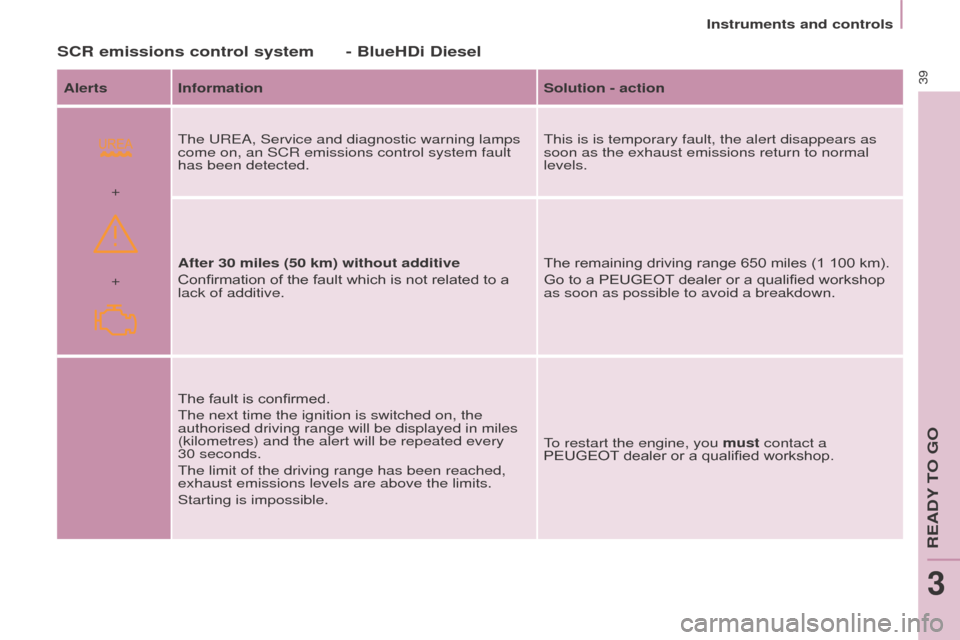
+ +Instruments and controls
39
SCR emissions control system
Alerts Information
Solution - action
The u R e A, Service and diagnostic warning lamps
come on, an SCR emissions control system fault
has been detected. This is is temporary fault, the alert disappears as
soon as the exhaust emissions return to normal
levels.
After 30 miles (50 km) without additive
Confirmation of the fault which is not related to a
lack of additive. The remaining driving range 650 miles (1 100 km).
Go to a PEUGEOT dealer or a qualified workshop
as soon as possible to avoid a breakdown.
The fault is confirmed.
The next time the ignition is switched on, the
authorised driving range will be displayed in miles
(kilometres) and the alert will be repeated every
30
seconds.
The limit of the driving range has been reached,
exhaust emissions levels are above the limits.
Starting is impossible. To restart the engine, you must contact a
PEUGEOT dealer or a qualified workshop.
- BlueHDi Diesel
ReADY to go
3
Page 42 of 296
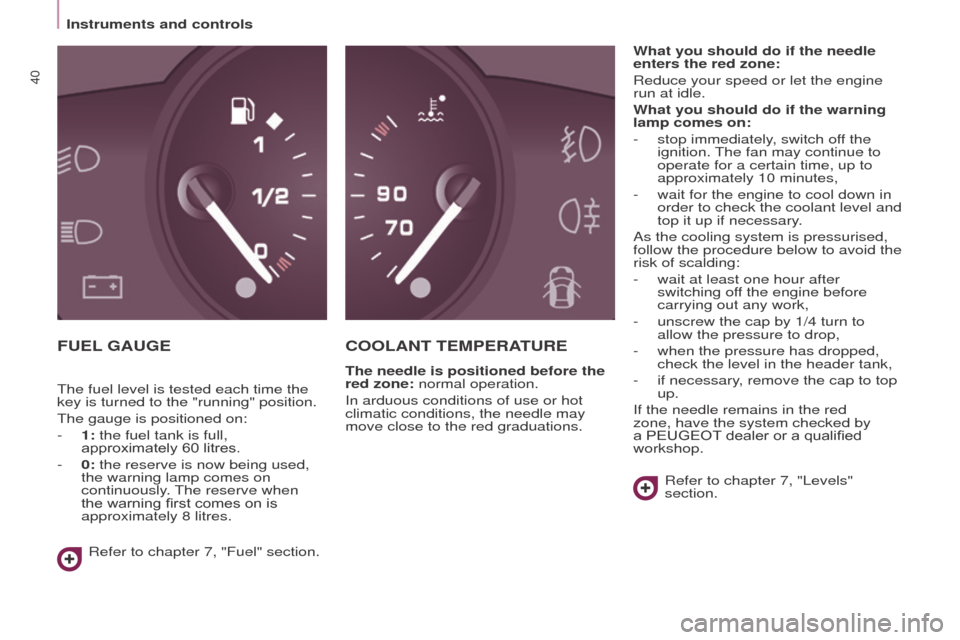
Instruments and controls
40
FueL gA uge Coo LAN t te MP e RAtu R e
the needle is positioned before the
red zone: normal operation.
In arduous conditions of use or hot
climatic conditions, the needle may
move close to the red graduations. What you should do if the needle
enters the red zone:
Reduce your speed or let the engine
run at idle.
What you should do if the warning
lamp comes on:
-
stop immediately
, switch off the
ignition. The fan may continue to
operate for a certain time, up to
approximately 10 minutes,
-
wait for the engine to cool down in
order to check the coolant level and
top it up if necessary
.
As the cooling system is pressurised,
follow the procedure below to avoid the
risk of scalding:
-
wait at least one hour after
switching of
f the engine before
carrying out any work,
-
unscrew the cap by 1/4 turn to
allow the pressure to drop,
-
when the pressure has dropped,
check the level in the header tank,
-
if necessary , remove the cap to top
up.
If the needle remains in the red
zone, have the system checked by
a PEUGEOT dealer or a qualified
workshop.
Refer to chapter 7, "Levels"
section.
Refer to chapter 7, "Fuel" section.
The fuel level is tested each time the
key is turned to the "running" position.
The gauge is positioned on:
-
1:
the fuel tank is full,
approximately 60 litres.
-
0:
the reserve is now being used,
the warning lamp comes on
continuously. The reserve when
the warning first comes on is
approximately 8 litres.
Page 43 of 296
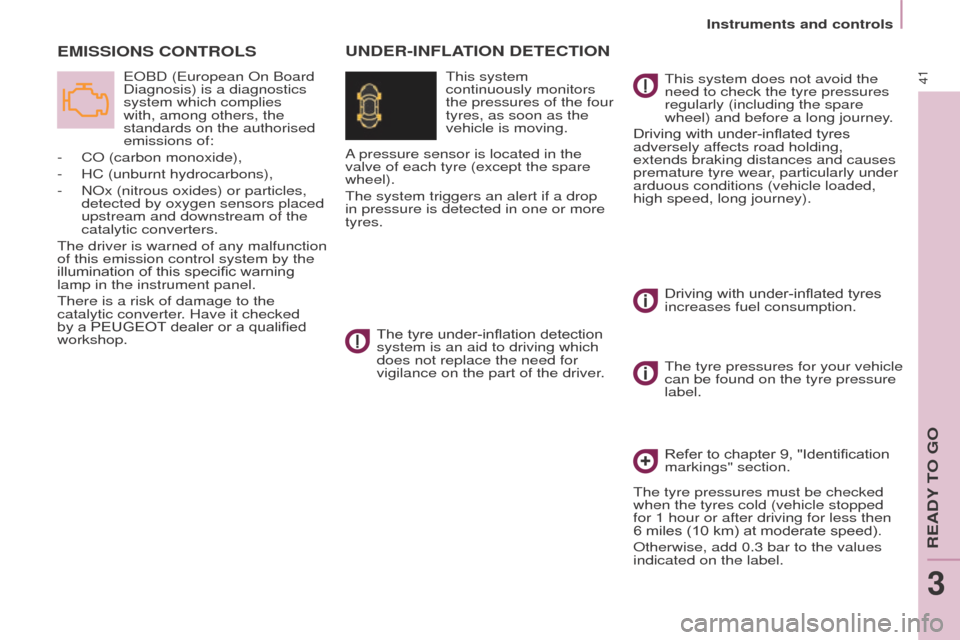
Instruments and controls
41
eMISSIoNS CoNtRoLS
eoBD (european on Board
Diagnosis) is a diagnostics
system which complies
with, among others, the
standards on the authorised
emissions
of:
-
C
o
(carbon monoxide),
-
HC (unburnt hydrocarbons),
-
N
o
x (nitrous oxides) or particles,
detected by oxygen sensors placed
upstream and downstream of the
catalytic converters.
The driver is warned of any malfunction
of this emission control system by the
illumination of this specific warning
lamp in the instrument panel.
There is a risk of damage to the
catalytic converter. Have it checked
by a PEUGEOT dealer or a qualified
workshop.
uNDeR-INFLAt I o N D ete C t I o N
This system
continuously monitors
the pressures of the four
tyres, as soon as the
vehicle is moving.
A pressure sensor is located in the
valve of each tyre (except the spare
wheel).
The system triggers an alert if a drop
in pressure is detected in one or more
tyres.
The tyre under-inflation detection
system is an aid to driving which
does not replace the need for
vigilance on the part of the driver. This system does not avoid the
need to check the tyre pressures
regularly (including the spare
wheel) and before a long journey .
Driving with under-inflated tyres
adversely affects road holding,
extends braking distances and causes
premature tyre wear, particularly under
arduous conditions (vehicle loaded,
high speed, long journey).
Driving with under-inflated tyres
increases fuel consumption.
The tyre pressures for your vehicle
can be found on the tyre pressure
label.
Refer to chapter 9, "Identification
markings" section.
The tyre pressures must be checked
when the tyres cold (vehicle stopped
for 1 hour or after driving for less then
6 miles (10 km) at moderate speed).
o
therwise, add 0.3 bar to the values
indicated on the label.
ReADY to go
3
Page 44 of 296
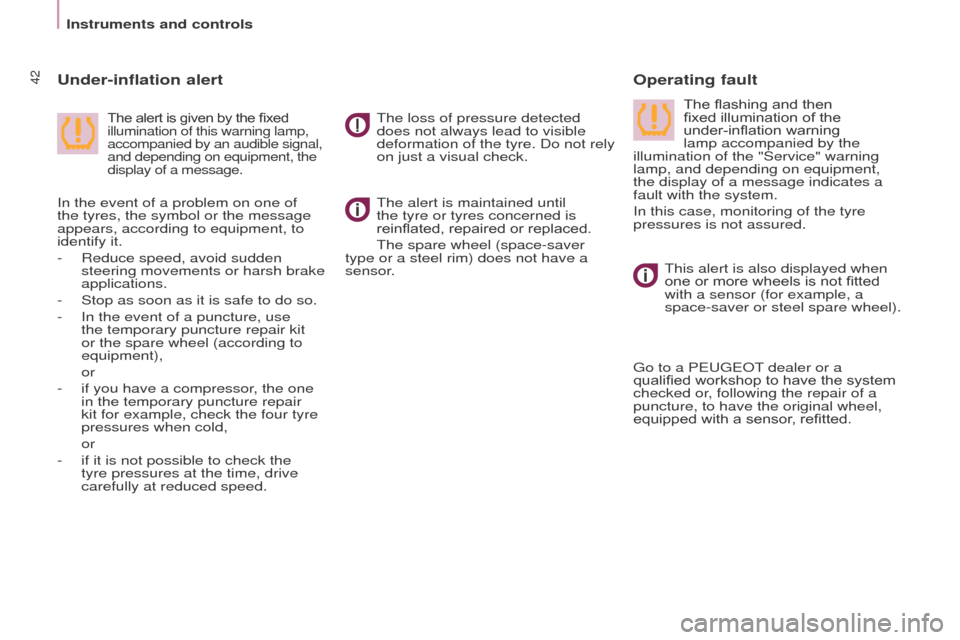
Instruments and controls
42
The alert is maintained until
the tyre or tyres concerned is
reinflated, repaired or replaced.
The spare wheel (space-saver
type or a steel rim) does not have a
sensor.
operating faultu
nder-inflation alert
The loss of pressure detected
does not always lead to visible
deformation of the tyre. Do not rely
on just a visual check.The alert is given by the fixed
illumination of this warning lamp,
accompanied by an audible signal,
and depending on equipment, the
display of a message.The flashing and then
fixed illumination of the
under-inflation warning
lamp accompanied by the
illumination of the "Service" warning
lamp, and depending on equipment,
the display of a message indicates a
fault with the system.
In this case, monitoring of the tyre
pressures is not assured.
In the event of a problem on one of
the tyres, the symbol or the message
appears, according to equipment, to
identify it.
-
Reduce speed, avoid sudden
steering movements or harsh brake
applications.
-
Stop as soon as it is safe to do so.
-
In the event of a puncture, use
the temporary puncture repair kit
or the spare wheel (according to
equipment),
or
-
if you have a compressor
, the one
in the temporary puncture repair
kit for example, check the four tyre
pressures when cold,
or
-
if it is not possible to check the
tyre pressures at the time, drive
carefully at reduced speed.
This alert is also displayed when
one or more wheels is not fitted
with a sensor (for example, a
space-saver or steel spare wheel).
g
o to a P eugeo T dealer or a
qualified workshop
to have the system
checked or, following the repair of a
puncture, to have the original wheel,
equipped with a sensor, refitted.
Page 45 of 296
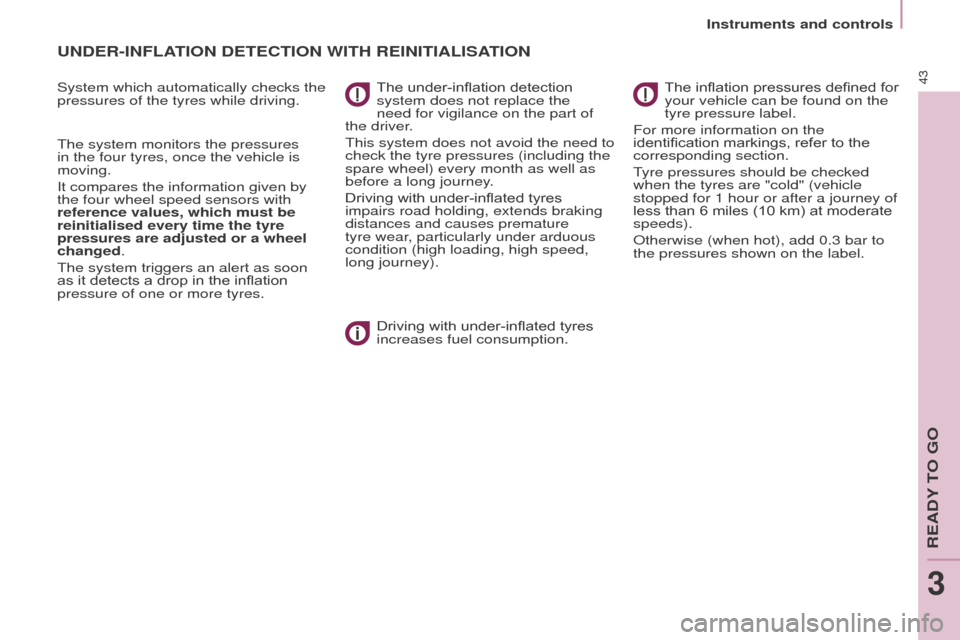
Instruments and controls
43
uNDeR-INFLAtI o N D ete C t I o N WI t H R e INI t IALISAt I o N
System which automatically checks the
pressures of the tyres while driving.
The system monitors the pressures
in the four tyres, once the vehicle is
moving.
It compares the information given by
the four wheel speed sensors with
reference values, which must be
reinitialised every time the tyre
pressures are adjusted or a wheel
changed.
The system triggers an alert as soon
as it detects a drop in the inflation
pressure of one or more tyres.The under-inflation detection
system does not replace the
need for vigilance on the part of
the
driver.
This system does not avoid the need to
check the tyre pressures (including the
spare wheel) every month as well as
before a long journey.
Driving with under-inflated tyres
impairs road holding, extends braking
distances and causes premature
tyre wear, particularly under arduous
condition (high loading, high speed,
long journey).
Driving with under-inflated tyres
increases fuel consumption. The inflation pressures defined for
your vehicle can be found on the
tyre pressure label.
For more information on the
identification markings, refer to the
corresponding section.
Tyre pressures should be checked
when the tyres are "cold" (vehicle
stopped for 1 hour or after a journey of
less than 6 miles (10 km) at moderate
speeds).
o
therwise (when hot), add 0.3 bar to
the pressures shown on the label.
ReADY to go
3
Page 46 of 296
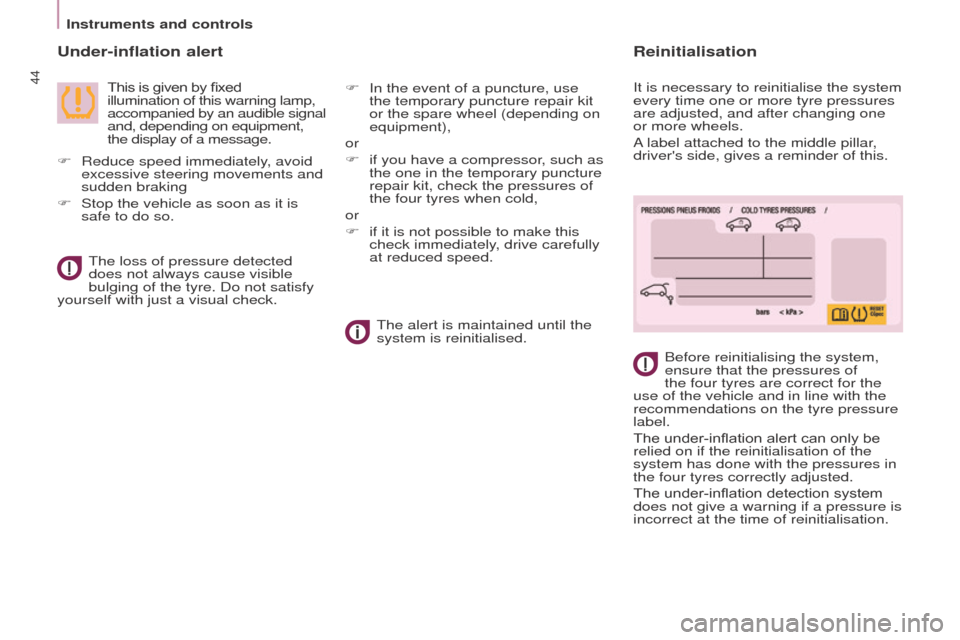
Instruments and controls
44
under-inflation alert
This is given by fixed
illumination of this warning lamp,
accompanied by an audible signal
and, depending on equipment,
the display of a message.Before reinitialising the system,
ensure that the pressures of
the four tyres are correct for the
use of the vehicle and in line with the
recommendations on the tyre pressure
label.
The under-inflation alert can only be
relied on if the reinitialisation of the
system has done with the pressures in
the four tyres correctly adjusted.
The under-inflation detection system
does not give a warning if a pressure is
incorrect at the time of reinitialisation.
The loss of pressure detected
does not always cause visible
bulging of the tyre. Do not satisfy
yourself with just a visual check.
The alert is maintained until the
system is reinitialised.
F
Reduce speed immediately
, avoid
excessive steering movements and
sudden braking
F
Stop the vehicle as soon as it is
safe to do so. F
In the event of a puncture, use
the temporary puncture repair kit
or the spare wheel (depending on
equipment),
or
F
if you have a compressor
, such as
the one in the temporary puncture
repair kit, check the pressures of
the four tyres when cold,
or
F
if it is not possible to make this
check immediately
, drive carefully
at reduced speed.
Reinitialisation
It is necessary to reinitialise the system
every time one or more tyre pressures
are adjusted, and after changing one
or more wheels.
A label attached to the middle pillar,
driver's side, gives a reminder of this.
Page 47 of 296
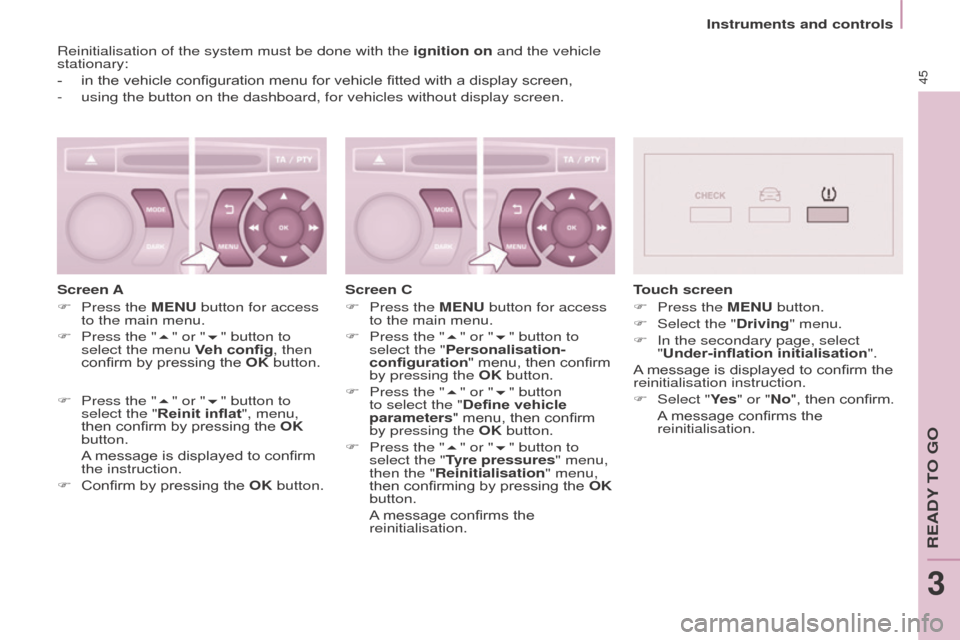
Instruments and controls
45
Reinitialisation of the system must be done with the ignition on and the vehicle
stationary:
-
in the vehicle configuration menu for vehicle fitted with a disp
lay screen,
-
using the button on the dashboard, for vehicles without display screen.
Screen A
F
Press the
M e N u button for access
to the main menu.
F
Press the "
5" or "6" button to
select the menu Veh config, then
confirm by pressing the
o K button.
F
Press the "
5" or "6" button to
select the "Reinit inflat", menu,
then confirm by pressing the
o K
button.
A
message is displayed to confirm
the instruction.
F
Confirm by pressing the
o K button.Screen C
F
Press the
M e N u button for access
to the main menu.
F
Press the "
5" or "6" button to
select the "Personalisation-
configuration" menu, then confirm
by pressing the
o K button.
F
Press the "
5" or "6" button
to select the "Define vehicle
parameters" menu, then confirm
by pressing the
o K button.
F
Press the "
5" or "6" button to
select the "
t
yre pressures
" menu,
then the "Reinitialisation" menu,
then confirming by pressing the
o K
button.
A
message confirms the
reinitialisation.
touch screen
F
Press the
M e N u button.
F
Select the "
Driving" menu.
F
In the secondary page, select
"
Under-inflation initialisation".
A message is displayed to confirm the
reinitialisation instruction.
F
Select "
Ye s" or "No", then confirm.
A
message confirms the
reinitialisation.
ReADY to go
3
Page 48 of 296
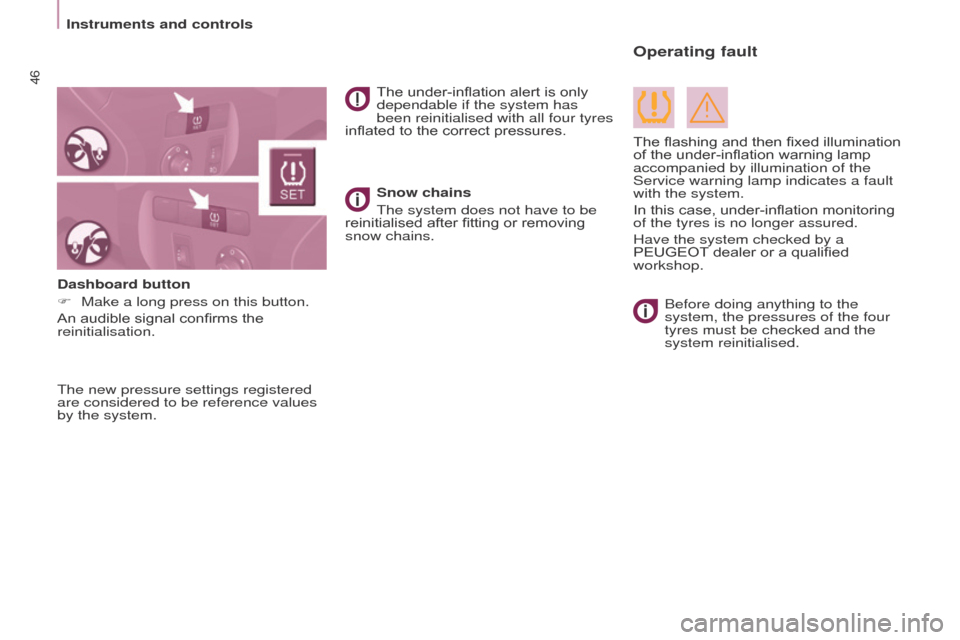
Instruments and controls
46
The new pressure settings registered
are considered to be reference values
by the system.The under-inflation alert is only
dependable if the system has
been reinitialised with all four tyres
inflated to the correct pressures.
Before doing anything to the
system, the pressures of the four
tyres must be checked and the
system reinitialised.
Snow chains
The system does not have to be
reinitialised after fitting or removing
snow chains.
Dashboard button
F
Make a long press on this button.
An audible signal confirms the
reinitialisation.
operating fault
The flashing and then fixed illumination
of the under-inflation warning lamp
accompanied by illumination of the
Service warning lamp indicates a fault
with the system.
In this case, under-inflation monitoring
of the tyres is no longer assured.
Have the system checked by a
PEUGEOT dealer or a qualified
workshop.
Page 49 of 296
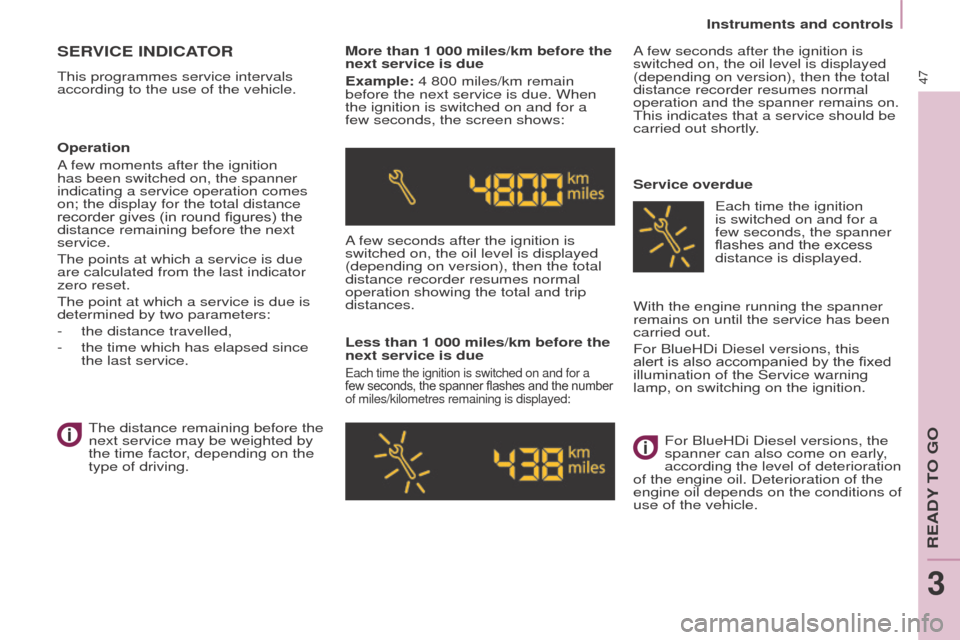
Instruments and controls
47
SeRVICe INDICAto R
This programmes service intervals
according to the use of the vehicle. More than 1 000 miles/km before the
next service is duee
xample: 4 800 miles/km remain
before the next service is due. When
the ignition is switched on and for a
few seconds, the screen shows:
A few seconds after the ignition is
switched on, the oil level is displayed
(depending on version), then the total
distance recorder resumes normal
operation showing the total and trip
distances.
Less than 1 000 miles/km before the
next service is due
each time the ignition is switched on and for a
few seconds, the spanner flashes and the number
of miles/kilometres remaining is displayed:
A few seconds after the ignition is
switched on, the oil level is displayed
(depending on version), then the total
distance recorder resumes normal
operation and the spanner remains on.
This indicates that a service should be
carried out shortly.
Service overdue
o
peration
A few moments after the ignition
has been switched on, the spanner
indicating a service operation comes
on; the display for the total distance
recorder gives (in round figures) the
distance remaining before the next
service.
The points at which a service is due
are calculated from the last indicator
zero reset.
The point at which a service is due is
determined by two parameters:
-
the distance travelled,
-
the time which has elapsed since
the last service. The distance remaining before the
next service may be weighted by
the time factor
, depending on the
type of driving. With the engine running the spanner
remains on until the service has been
carried out.
For BlueHDi Diesel versions, this
alert is also accompanied by the fixed
illumination of the Service warning
lamp, on switching on the ignition.
e
ach time the ignition
is switched on and for a
few
seconds, the spanner
flashes and the excess
distance is displayed.
For BlueHDi Diesel versions, the
spanner can also come on early,
according the level of deterioration
of the engine oil. Deterioration of the
engine oil depends on the conditions of
use of the vehicle.
ReADY to go
3
Page 50 of 296
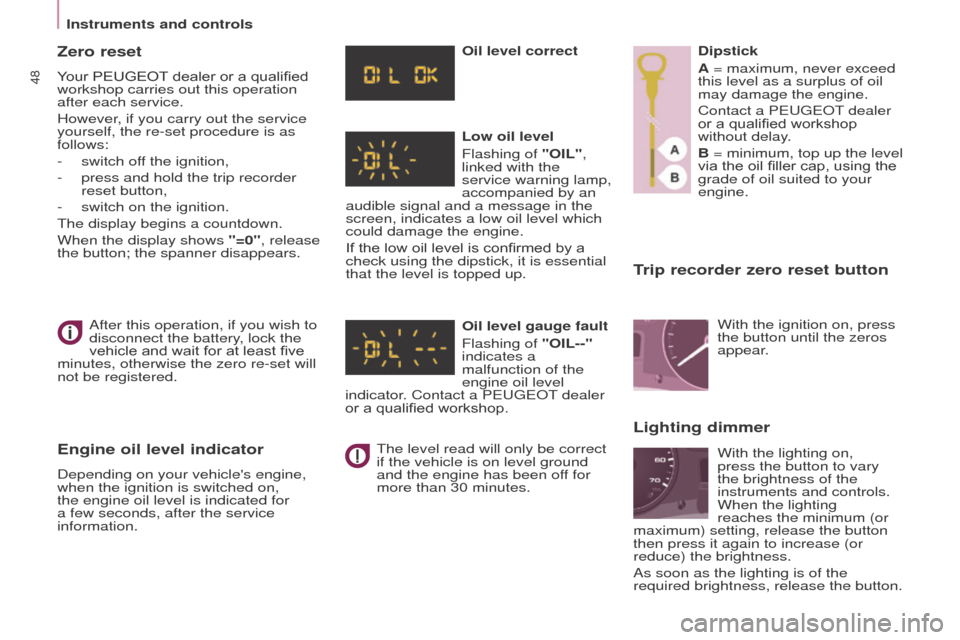
Instruments and controls
48
trip recorder zero reset button
After this operation, if you wish to
disconnect the battery, lock the
vehicle and wait for at least five
minutes, otherwise the zero re-set will
not be registered.
engine oil level indicator
Depending on your vehicle's engine,
when the ignition is switched on,
the engine oil level is indicated for
a few
seconds, after the service
information.
o
il level correct
Low oil level
Flashing of " o IL",
linked with the
service warning lamp,
accompanied by an
audible signal and a message in the
screen, indicates a low oil level which
could damage the engine.
If the low oil level is confirmed by a
check using the dipstick, it is essential
that the level is topped up.
o
il level gauge fault
Flashing of " o IL--"
indicates a
malfunction of the
engine oil level
indicator. Contact a P eugeo T dealer
or a qualified workshop.
The level read will only be correct
if the vehicle is on level ground
and the engine has been off for
more than 30 minutes. Dipstick
A = maximum, never exceed
this level as a surplus of oil
may damage the engine.
Contact a P
eugeo T dealer
or a qualified workshop
without delay.
B = minimum, top up the level
via the oil filler cap, using the
grade of oil suited to your
engine.
Lighting dimmer
With the ignition on, press
the button until the zeros
appear.
With the lighting on,
press the button to vary
the brightness of the
instruments and controls.
When the lighting
reaches the minimum (or
maximum) setting, release the button
then press it again to increase (or
reduce) the brightness.
As soon as the lighting is of the
required brightness, release the button.
Zero reset
Your PEUGEOT dealer or a qualified
workshop carries out this operation
after each service.
However, if you carry out the service
yourself, the re-set procedure is as
follows:
-
switch of
f the ignition,
-
press and hold the trip recorder
reset button,
-
switch on the ignition.
The display begins a countdown.
When the display shows
"=0", release
the button; the spanner disappears.